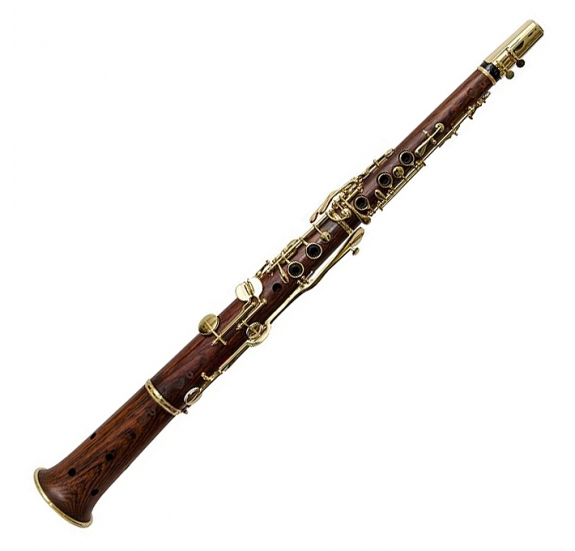Tárogató
Woodwinds
Europe
Between 1001 and 1900 AD
Video
The tárogató is a distinctive woodwind instrument primarily associated with Hungarian folk music. It is recognized for its unique sound, which resembles that of a soprano saxophone but is characterized by a conical bore and a single reed mouthpiece. The tárogató has become a symbol of Hungarian national identity and is often featured in traditional and contemporary music settings.
Purpose and Usage
The tárogató serves multiple purposes:
It plays a vital role in Hungarian folk traditions, often performed at festivals, weddings, and other cultural events. Historically, the tárogató was used as a signaling instrument in military contexts, similar to the bugle or bagpipe, due to its loud and penetrating sound.
Musical Versatility: In modern contexts, it has found a place in orchestral music and world music genres, showcasing its adaptability beyond traditional folk settings.
Musical Characteristics
The tárogató produces a unique sound that blends qualities of both the saxophone and English horn. It has a wide tonal range and can produce both powerful and subtle tones depending on the player’s technique. The most common type is the soprano tárogató, pitched in B♭, but there are various sizes available, including contrabass versions. Each type offers different tonal qualities and applications in music
Mechanism and Functionality
The modern tárogató operates through the following characteristics:
Similar to that of a clarinet, allowing for a wide range of tonal expression. This design contributes to its unique sound and facilitates easier transitions between registers compared to cylindrical instruments like the clarinet. Modern variants include a system of keys that enhance playability and intonation accuracy, distinguishing them from their historical predecessors
Types of Tárogatók
There are several types of tárogatók, each varying in size and pitch:
Soprano Tárogató: The most common type, typically pitched in B♭.
Contrabass Tárogató: A larger version pitched in E♭.
Various Sizes: Some makers have produced multiple sizes to accommodate different musical needs
Historical Context
The history of the tárogató is rich and complex:
Origins: The instrument’s lineage can be traced back to the 15th century, with influences from Middle Eastern instruments like the zurna. It was introduced into Hungary during the Turkish invasions in the Middle Ages.
Evolution: Originally a double-reed shawm, the tárogató underwent significant transformation in the late 19th century when W. Joseph Schunda adapted it into its modern form with a single reed mouthpiece and key system.
Cultural Symbolism: The tárogató became emblematic during the Rákóczi’s War for Independence (1703–1711) and was subsequently banned by Habsburg authorities due to its association with Hungarian nationalism. Its revival occurred post-1848 as part of Hungary’s movement towards nationhood.
The tárogató is a significant woodwind instrument deeply rooted in Hungarian culture and history. Its importance can be understood through its cultural role, historical evolution, and musical characteristics.
Cultural Significance
The tárogató is prominently featured in Hungarian folk music, often associated with traditional celebrations and performances. Its mournful sound evokes deep emotional expressions, making it a favorite among folk musicians.
The instrument has become a symbol of Hungarian national identity, especially during periods of struggle for independence. It was notably linked to the Rákóczi’s War for Independence (1703–1711), which led to its suppression by the Habsburg monarchy due to its associations with nationalism.
FAQ
Why was the tárogató considered too overpowering for concert halls?
The tárogató, a traditional Hungarian woodwind instrument, was considered too overpowering for concert halls due to its loud, piercing tone. Designed for outdoor performances, its sound was intended to carry over large distances. In smaller, enclosed spaces, its resonance could overwhelm other instruments and disrupt the hall's acoustics, making it challenging to achieve a balanced performance.
What role did the tárogató play in Hungarian military history?
The tárogató played a symbolic and functional role in Hungarian military history, serving as a signaling instrument during battles in the 17th and 18th centuries. It became a symbol of national resistance, particularly during the wars of independence led by Ferenc Rákóczi II, embodying the spirit of Hungarian identity and defiance against oppression.
How does the tárogató differ from other woodwind instruments?
The tárogató stands out from other woodwind instruments due to its unique design and sound. Unlike the clarinet or oboe, it features a conical bore and a wooden body, producing a warm, expressive tone that blends elements of the saxophone and oboe. Its single-reed design is similar to a clarinet, but the tárogató's emotional, folk-inspired sound reflects its deep cultural roots in Hungarian music and history.
 Links
Links
References
Other Instrument
Categories


















